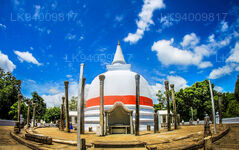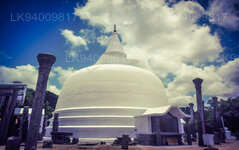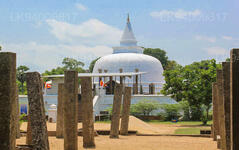
مدينة أنورادهابورة
أنورادهابورة هي إحدى عواصم سريلانكا القديمة، وتشتهر بآثارها المحفوظة جيدًا للحضارة السريلانكية القديمة. تقع المدينة، المدرجة حاليًا على قائمة اليونسكو للتراث العالمي، على بُعد 205 كيلومترات شمال العاصمة الحالية كولومبو في سريلانكا.
Lankaramaya (ලංකාරාමය)
Lankaramaya in Sri Lanka: A Temple with Over Two Millenia of History
The tale of the temple Lankaramaya in Sri Lanka is the stuff of legend. The year 103 BC was a memorable year for the King Walagamba (also known as Vattagamini Abaya) of Anuraddhapura. As the rightful king he had been attacked by invaders of the kingdom, and during that year he hid out at a place called Silasobha Khandaka and planned their defeat. His plans worked out well and the invaders were destroyed in the same year, enabling him to be enthroned following the failed invasion.
Silasobha Khandaka held a very special place in his memories, as the place that saved his life and from where he started on the road to his reign. Therefore, he built a stupa in its memory and named it Silasobha Khandaka Cetiya. The stupa was similar in architecture to the Thuparama, the first stupa to be built after the establishment of Buddhism in Sri Lanka in 250 BC. It was built with 88 pillars supporting the roof of the vatadage which appears to have been 45 feet in diameter. The vatadage was a roofed hall like structure that surrounded the actual stupa in the centre, with the entire structure built at 10 feet above ground level.
Lankaramaya in Sri Lanka: Present day status of the Temple
Today the actual stupa has been renovated, but little remains of the vatadage except the ruins of a few broken pillars in the middle of the large courtyard. The name of the stupa too has been changed from Silasobha Khandaka Cetiya to the simpler Lankaramaya.
Lankaramaya, along with the Elephant pond and the old underground canal network (dating back hundreds of years) are excellent examples of the complex architecture used millenia ago. They are interesting sites for archeology and histoty lovers. Lankaramaya is definitely a great place to visit on your holiday to Sri Lanka’s Ancient Kingdom Anuraddhapura.
نبذة عن منطقة أنورادهابورا
أنورادهابورة تابعة لمقاطعة شمال وسط سريلانكا. تُعد أنورادهابورة إحدى العواصم القديمة لسريلانكا، وتشتهر بآثارها المحفوظة جيدًا للحضارة السريلانكية القديمة. تقع المدينة، المدرجة حاليًا على قائمة اليونسكو للتراث العالمي، على بُعد 205 كم شمال العاصمة الحالية كولومبو في سريلانكا. تضم مدينة أنورادهابورة المقدسة وفي محيطها عددًا كبيرًا من الآثار. تتكون الآثار من ثلاثة أنواع من المباني: داجوبا، ومباني رهبانية، وبوكونا (برك). كانت المدينة تتميز ببعض من أكثر أنظمة الري تعقيدًا في العالم القديم، وتقع في المنطقة الجافة من البلاد، وقد بنت الإدارة العديد من الخزانات لري الأرض. معظم السكان من السنهاليين، بينما يعيش التاميل والمسلمون السريلانكيون في المنطقة.
نبذة عن مقاطعة شمال الوسط
مقاطعة شمال الوسط وهي أكبر مقاطعة في البلاد تغطي 16٪ من إجمالي مساحة البلاد. تتكون مقاطعة شمال الوسط من منطقتين تسمى بولوناروا وأنورادهابور. أنورادهابور هي أكبر مقاطعة في سريلانكا. تبلغ مساحتها 7128 كيلومترًا مربعًا. تتمتع مقاطعة شمال الوسط بإمكانيات عديدة للمستثمرين لبدء أعمالهم التجارية، وخاصة الزراعة والصناعات القائمة على الزراعة وقطاعات الثروة الحيوانية. يعتمد أكثر من 65٪ من سكان مقاطعة شمال الوسط على الزراعة الأساسية والصناعات القائمة على الزراعة. كما أطلق عليها NCP اسم "Wew Bendi Rajje" نظرًا لوجود أكثر من 3000 خزان متوسط وكبير الحجم في المقاطعة. سري ماها بودييا، ورووانويلي سيا، وتوباراما داجيبا، ودير أباياجيري، وبولونارووا رانكوت ويهيرا، ولانكاثيليك خائفون

















